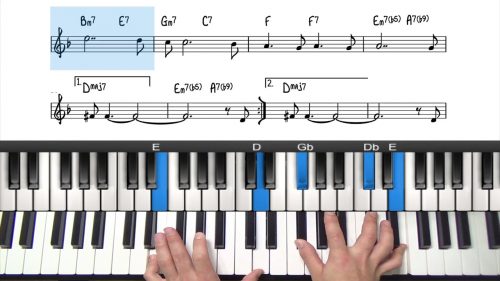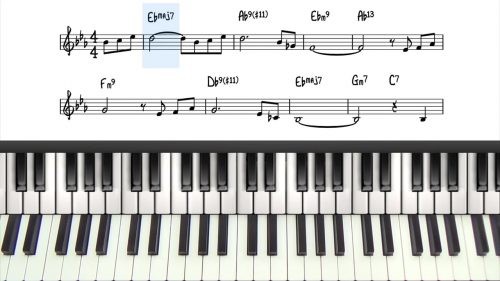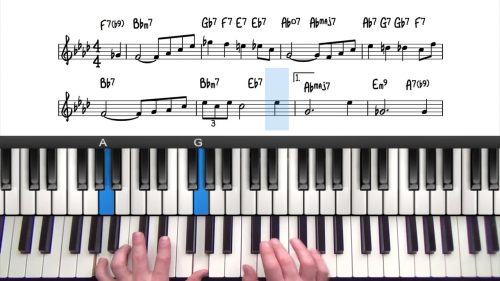Satin Doll Tutorial Part 2
From watching part 1 you should now be familiar with the form, the melody and the chord changes. We will now explore some more stylistic aspects of how the tune is commonly played.
This lesson starts with a discussion about the pedal point that we used in the introduction and then we’ll focus on our left hand, looking at approach patterns and passing tones to create more interesting bass patterns in the lower registers.
We then explore the turnaround options and variations that are available to us.
The final section of the tutorial moves into rootless comping voicings where we focus on 3 main types of voicings:
-
The 4 Way Close which is a early style of block chord.
-
Red Garland Voicings which are constructed from a rootless voicing in the left hand and an octave in the right hand with a perfect 5th interval in the middle.
- Quartal Voicings which are derived from pentatonic harmony.
Practice Tips
-
Whilst the basic principles of these comping voicings can be taught, you need to be listening to the jazz masters who specialise in these styles.
-
For the 4 Way Close, listen to the recordings of George Shearing and Barry Harris.
-
For Red Garland Voicings, Red himself is a good place to start! Ahmad Jamal also has a similar sound in his comping style.
-
Pentatonic voicings are more of a modern sound and so listen to players such as Herbie Hancock and Chick Corea.
- A wealth of information can be learnt from just listening to these notable jazz musicians.







Thanks for this lesson which covered a number of interesting topics. I’ve played this tune for years but still found lots of new ideas. Loved the Michel Petrucciani base movement. Looking forward to the improvising lesson also the new site.
Brian Smith
Hi Brian! Glad you enjoyed the lesson and found some new ideas. You can do a lot with “Satin Doll” considering how simple the form is, and it’s a brilliant tune to apply different block chord styles.
Yes I also like Petrucciani’s arrangement of the tune. There’s some interesting things that can be lifted from his performance of the tune.
Great stuff, the improv lesson will be finished soon. I think it would be nice to create a dedicated course around this tune on the new site.
Cheers,
Hayden
Hi enjoyed the lesson – you mentioned your plans to provide a followup improv lesson for satin doll — any updates on that? Thanks
Hi Charlie,
Thanks for the message and glad you enjoyed the lesson.
We experimented with improvisation tutorials on specific tunes, you can see some in this course: pianogroove.com/jazz-piano-lessons/how-to-improvise/
The problem is that improvisation is a personal and spontaneous process, and by visually copying an improvisation from a video tutorial, the true sense of improvisation is lost and not much gained by the student.
We decided a better route to go down is to educate students on the process of transcription – see this video: pianogroove.com/community/t/the-importance-of-listening-transcribing/2737
and to set transcription exercises to equip students with the skills they need to examine and emulate their favourite solos. See the transcription exercises here: pianogroove.com/community/c/improvisation-exercises
My recommendation would be to create a playlist of Satin Doll records with improvisations that you personally like the sound of. This doesn’t just have to just be the solos of piano players, it can be all instruments.
If this is difficult you can start with some of Tuomo’s transcription exercises to develop your ear skills.
Dedicate a proportion of your daily practice time to listening and transcription and within the space of a year you will be a much more comfortable and competent improviser.
Understand that transcription is the most efficient and effective way to learn to improvise, and the sooner that we incorporate this into our practice routines the better.
Check out the links above and let me know if you have any further questions.
Cheers,
Hayden